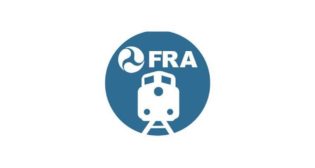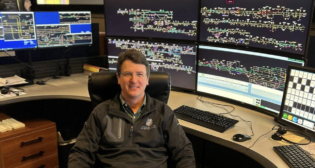
Entrepreneurial railroader
Written by Douglas John BowenFrom branch line to blockbuster, the Indiana Rail Road story is largely that of one man's visionary leadership: Founder and chief executive Thomas G. Hoback.
When the history of 21st-century railroading is written sometime in the far future, the accomplishments of Thomas G. Hoback—Founder, President, and Chief Executive Officer of the Indiana Rail Road Co.—will be chronicled as an example of the type of visionary leadership that made a notable impact on a resurgent industry. The story of this Indianapolis-based 500-mile regional railroad, with routes linking Chicago to Indianapolis, Louisville, Ky.,and central Illinois, will be studied closely by not only railroad historians, but by economists, transportation planners, logistics specialists, and marketers.
“Tom’s deep passion for the rail industry, fostered as a child and developed through six decades, has allowed him to take a broken-down branch line and convert it into a pillar of the industry,” loyal Indiana Rail Road employees say about their leader. “He has become known as an industry thought leader and tireless promoter of rail’s public benefits.” He is an example of how an executive can be a combination of “visionary entrepreneur and shrewd businessman, with great compassion for the community, responsible for myriad contributions to education, historic preservation, and the arts.”
Born 1947 in Peoria, Ill., Hoback grew up in nearby Chillicothe and then Ft. Madison, Iowa, where his father was a dispatcher for the Santa Fe Railway. His first railroad job was as a summertime track laborer for Santa Fe during college. He graduated from Golden Gate University in San Francisco with a Bachelor of Science degree in transportation and economics in 1969, and initially worked for rail shipper Foremost-McKesson and the Western Pacific Railroad before returning to the Midwest in 1977. At the Western Pacific, Hoback, an economic analyst, began to understand the inefficiencies of railroading at the time.
“We had just purchased 100 new mechanical refrigerator cars, to compete with the Southern Pacific,” he recalls. “I was shocked that we were getting only one turn per month out of our most expensive cars. On top of that, our rates were uneconomical. It was a real eye-opener.”
After a year as vice president marketing for short line Erie Western, Hoback joined Illinois Central Gulf as Director of Coal Marketing in 1978. He was recruited by Senior Vice President Marketing Harry Bruce, who had worked with the young Hoback at Western Pacific.
It was at ICG where his entrepreneurial leanings began to blossom. Hoback joined TECO Energy (Tampa Electric) in 1983 so he could begin negotiating for purchase of ICG’s 110-mile Indianapolis-Sullivan, Ind., rail line, which ICG had unsuccessfully petitioned to abandon in 1977.
Fast-forward to March 18, 1986: Banking largely on the potential of one of the largest contiguous untapped coalfields in the nation—for which Peabody Energy had mineral rights—Hoback closed the purchase of, and began operating, INRD. He extended the railroad to Newton, Ill., in 1990.
INRD in 1986 may have been viewed by others as a questionable investment: There were literally thousands of track defects on the 110-mile line, and a single coal customer with 12,000 annual carloads represented 92% of all business. But to Hoback, the long-neglected branch line and its 16 employees represented opportunity. Over the next 28 years, he personally oversaw the complete rebuilding of INRD from a decrepit branch line into a heavy-haul, high-tech regional railroad, investing more than $180 million in private capital, and transforming the operation into an industry leader in entrepreneurial business development and operations practices.
Gateways to greater growth
In 2006, in a major strategic move, INRD gained access to the Chicago and Louisville gateways with a winning bid for Canadian Pacific’s Indiana operations, extending its route system north to Chicago and east to the Ohio River ports at Louisville.
In 2013—a “transformational year”—Hoback took a major but calculated risk, convincing Class I partner CN to inaugurate all-rail intermodal service for Asia-Indiana trade, and investing more than $2 million in private capital to open an Indianapolis intermodal hub. The service exceeded its budgeted intermodal volumes for 2014. INRD also opened the Odon, Ind., Transload, strategically placed to reach under-served southwest Indiana companies, as well as a $7.5 million, state-of-the-art locomotive maintenance facility.
INRD today is a 500-mile system with 170,000 annual carloads, 182 employees, a 12% growth rate compounded annually over 28 years, and an increase in annual gross ton-miles of nearly 3,400%. More than 90% of the main line is 136-pound welded rail, with 29 miles under CTC. Coal, while growing, represents only 50% of revenue, because INRD’s intermodal and carload business continues to expand. With a sharp sense of political trends, Hoback has led INRD on a multi-year traffic-diversification push that has paid off. Merchandise carloads represented 7% of INRD revenue in 1986. In 2013, nearly half of revenue was carload. Due to intermodal and more carload development, this is expected to increase in 2015 and beyond. In 2016, INRD’s 30th year, the railroad will reach $200 million in private capital investment since its inception. That’s more than 33 times its original purchase price.
INRD moved its two-millionth revenue carload of freight in the fourth quarter of 2011, an accomplishment that helped earn it Railway Age’s Regional Railroad of the Year award in 2012.
INRD is also technology pioneer, hosting tests for a Cummins-supplied, EPA Tier 4 compliant QSK95-powered locomotive, due to be completed this year. While achieving all this, INRD has maintained an operating ratio in the low 60s and achieved revenue records for three consecutive years.
Commitment to the community
Hoback has always been committed to the betterment of the community. 2014 was the 25th year for INRD’s Santa Train. The railroad also donated $50,000 to help a local school stay open. Elected to the Indiana Historical Society board of trustees in 2002, Hoback completed a three-year term as chairman in 2011. He has a long-standing association with the Society, having cofounded the Midwest Railroad Research Center in 1997. He is also active on other boards and advisory committees, among them the board of directors of the Eiteljorg Museum of American Indians and Western Art, the John W. Barriger III National Railroad Library at the University of Missouri-St. Louis (serving on the editorial advisory board for Railroad History), and The Lexington Group in Transportation History, an informal group of academics, authors, professional railroaders, and historians.
“Building a contiguous railroad that adds value to each property works for us,” Hoback says. “We’ve learned how to extract value from each piece. I’ve seen many smaller properties absorbed into large carriers who are looking mainly at linehaul service, and are not interested in regional customers. We’ve really proven that there is a role for regional railroads in the watershed surrounding Chicago.”
In his 46-year career, Hoback, who retires this year, has witnessed many changes. “I started when the railroads were heavily regulated,” he says. “It was a corrosive environment that too often supported a ‘can’t-do’ attitude. Railroads were afraid that if they did something good for one customer, they would have to do it for others. They were hemorrhaging business. They were essentially regulated public utilities, where nothing ever happens. When partial deregulation occurred in 1980 under the Staggers Act, many of the railroads didn’t want it, not just because they were concerned about a loss of some antitrust exemption, but because they really didn’t know how to compete in a free market. It was cultural paralysis.”
That cultural paralysis has given way “to an industry where consolidation has allowed us to become much more efficient,” Hoback notes. But more important, it is an industry where entrepreneurial railroaders like the man at the helm of the Indiana Rail Road can make a difference, not only for customers, employees, and investors, but for the community.



